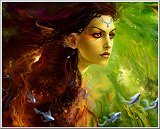



![]() In Greek mythology, Nymphs were spirits of nature.
Even though they were
female divinities of lower rank, still they were revered as the protectors of springs, mountains,
grottoes, trees, the sea and rivers. The Greeks peopled all parts of nature with
them and portrayed Nymphs as young, pretty girls, each subtype presiding over
whichever aspect of nature they represented.
In Greek mythology, Nymphs were spirits of nature.
Even though they were
female divinities of lower rank, still they were revered as the protectors of springs, mountains,
grottoes, trees, the sea and rivers. The Greeks peopled all parts of nature with
them and portrayed Nymphs as young, pretty girls, each subtype presiding over
whichever aspect of nature they represented.
Depending of where they resided, the Nymphs are as follows: Dryads (forests), Naiads (springs and rivers), Nereids (the Mediterranean), Oceanids (the sea) and Oreads (mountains), Limoniads (meadows), Limniads (lakes, marshes and swamps), Meliads (ash-trees), Epimeliads (protectors of sheep) and Napaea (valleys and glens). There are more categories of Nymphs, the names varying according to the ancient sources.
Though living for many years, Nymphs are nevertheless fated to die, even though some of them talk and carry on as if they were immortal. The sacrifices offered to Nymphs very often consisted of lambs, goats, milk and oil, but never of wine. They were worshipped in a nymphaeum, a monumental fountain which was raised in the vicinity of a well. The male counterpart of a nymph is the Satyr.
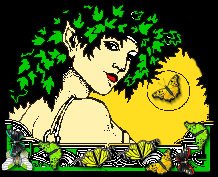
![]() The Dryads (Dryades, Hamadryades,) are female spirits of nature who preside
over the groves and forests. Each one is born with a certain tree over which she
watches - she comes into existence with it and often lives in a tree, in which case she is called a
hamadryad.
The Dryads (Dryades, Hamadryades,) are female spirits of nature who preside
over the groves and forests. Each one is born with a certain tree over which she
watches - she comes into existence with it and often lives in a tree, in which case she is called a
hamadryad.
The lives of the Dryads are critically connected with that of their trees; should the tree perish, then she dies with it. If this is caused by a mortal, the gods will surely punish him for that deed. The Dryads themselves will also punish any thoughtless mortal who would somehow foolishly or cruelly injure the trees. Some sources specifically call Meliads Nymphs of the Ash-tree and Heleads Nymphs of the Fen. Dryads were very often associated with the Oak-tree.
The ancient Greeks told this cautionary tale: A woman named Byblis or Biblis fell in love with her own brother and was naturally refused. Or else she was innocent and it was her brother who conceived a passion for her, as some writers say. Because of this she was consumed by her own tears and transformed into a fountain, or else she was turned into an Hamadryad Nymph, by the Nymphs. Others say that Byblis in shame killed herself.
Dionysus, the god of wine, as a baby was entrusted to the Nymphs of Mount Nysa, where they raised him in a cave, out of sight of Zeus' wife, Hera, who was looking to harm the child. It was there that Dionysus invented wine, perhaps his most famous and celebrated accomplishment.

![]() The Naiads (Naiades) were nymphs of bodies of fresh water and were one of the three main
classes of water nymphs - the others being the Nereids (nymphs of the
Mediterranean Sea) and the Oceanids (nymphs of the oceans). The Naiads
presided over rivers, streams, brooks, springs, fountains, lakes, ponds, wells, and
marshes. They were divided into various subclasses: Crinaeae (fountains),
Pegaeae (springs), Eleionomae (marshes),
Potameides (rivers), and Limnades or
Limnatides (lakes). Roman sources even assigned custody of the rivers of Hades
to Naiads classified as Nymphae Infernae Paludis or the
Avernales.
The Naiads (Naiades) were nymphs of bodies of fresh water and were one of the three main
classes of water nymphs - the others being the Nereids (nymphs of the
Mediterranean Sea) and the Oceanids (nymphs of the oceans). The Naiads
presided over rivers, streams, brooks, springs, fountains, lakes, ponds, wells, and
marshes. They were divided into various subclasses: Crinaeae (fountains),
Pegaeae (springs), Eleionomae (marshes),
Potameides (rivers), and Limnades or
Limnatides (lakes). Roman sources even assigned custody of the rivers of Hades
to Naiads classified as Nymphae Infernae Paludis or the
Avernales.
The Naiad was intimately connected to her body of water and her very existence seems to have depended on it. If a stream dried up, its Naiad expired. The waters over which Naiads presided were thought to be endowed with inspirational, medicinal, or prophetic powers. Whoever drank of these magical waters would be inspired, thus the Naiads were themselves considered prophetic and were frequently worshipped by the ancient Greeks in association with divinities of fertility and growth. Hence all persons in a state of rupture, such as madmen, poets, seers and prophets, were said to be caught by the Nymphs.
The genealogy of the Naiads varies according to geographic region and literary source. Naiads were either daughters of Zeus, daughters of various river gods, or simply part of the vast family of the Titan Oceanus. Like all the nymphs, the Naiads were in many ways female sex symbols of the ancient world and played the part of both the seduced and the seducer. Zeus in particular seems to have enjoyed the favors of countless Naiads and the other gods do not seem to have lagged far behind.
Take Cyrene, for example. She was reared near Mount Pelion and was extraordinarily beautiful. Apollo found her without spears wrestling alone with a lion and carried her off to that part of Libya where in later times he founded a city and named it, after her, Cyrene.
The Naiads fell in love with and actively pursued mortals as well. Classical literature abounds with the stories of their love affairs with gods and men and with the tales of their resulting children.
A gorgeous nymph named Dryope and her sister Naiads of a spring in Bithynia (or Mysia) fell in love with a very handsome mortal named Hylas (squire and companion of Heracles) as he filled his pitcher from their spring. Dryope and her sisters begged Hylas to live with them in their underwater grotto, and lured him into their waters.
This put an end to his part of the voyage with Jason and the Argonauts on their quest for the Golden Fleece, and caused his best buddy Heracles to also leave the crew of the Argo and spend months searching for his pal. Some ancient sources claim that Hylas was transformed into an echo by the Naiads, and as Heracles boomed the name 'Hylas', it would echo back at him, nearly driving the hero nuts.
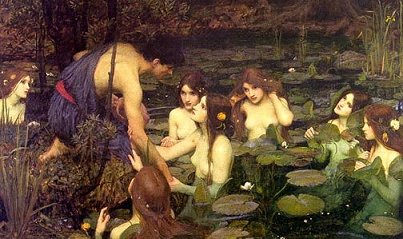
Artwork by Waterhouse, John William
But not all Naiads were willing accomplices: Arethusa, a nymph of a spring, was a huntress with whom the river god Alpheus fell in love. Arethusa, unwilling to marry, crossed to the island Ortygia, and there turned from a woman to a spring to escape from her pursuer. But when she changed into a spring the river Alpheus quickly mingled with it his own waters, thus achieving his purpose.
Amalthea was a Naiad, and famous as a nurse of Zeus, when he was a baby being reared in Crete. Amalthea owned a horn which could supply food in abundance, in other words she possessed the original Horn of Plenty. (Other sources claim that she had been a goat or to have owned a she-goat who suckled Zeus, and from the goat's skin Zeus fashioned his fearsome Aegis, his protective shield.)
But Zeus wasn't always loving towards Nymphs: Lara, a Naiad daughter of the River God Almo, could not hold her tongue and reported to Hera that Zeus loved a mortal woman named Juturna. Zeus punished Lara for this by wrenching from her the indiscreet tongue, and told Hermes to take her to Hades as she was to become an infernal Nymph. In this way she became Tacita, The Silent Goddess (Dea Muta). Lara consorted with Hermes and gave birth to the Lares, twin brothers, who guard the crossroads and ever keep watch in the city.
Greek towns and cities were called after the names of Naiads. Lilaea, in Phocis, was named for Lilaea, the Naiad of the Cephissus River.
There is a reference in Homer's Odyssey to a cave, rather than a body of water, that is sacred to the Naiads. It might be assumed, therefore, that this cave in Ithaca may have contained a spring or have been the source of a stream or brook.

![]() The Nereids are
most often described as the fifty daughters of Nereus and Doris, who dwell in the
Mediterranean Sea and served as attendants to the goddess Thetis. The King of
the Seas, mighty Poseidon, was also sacred to them. In the ancient writer
Hesiod's creation myths, the Nereids were mermaids who sprang from the union
between the Sea and its Rivers.
The Nereids are
most often described as the fifty daughters of Nereus and Doris, who dwell in the
Mediterranean Sea and served as attendants to the goddess Thetis. The King of
the Seas, mighty Poseidon, was also sacred to them. In the ancient writer
Hesiod's creation myths, the Nereids were mermaids who sprang from the union
between the Sea and its Rivers.
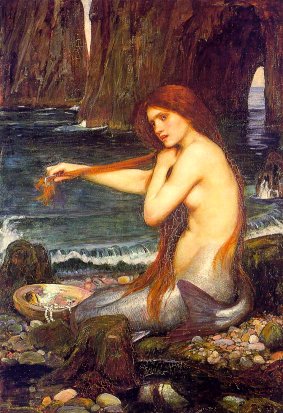
Artwork
by Waterhouse, John William
These beautiful women were most often portrayed as friendly and helpful towards sailors fighting perilous storms or treacherous sea passages, but Nereids could be vengeful. When Cassiopeia vainly bragged that she and her daughter, Andromeda, were more beautiful than the Nereids, they pleaded their case to Poseidon. He dispatched a terrible sea monster to terrorize Cassiopeia's city of Philistia. Cassiopeia and her husband, Cepheus, were eventually turned to stone as a result, but eventually both she and Cepheus, along with Andromeda, were turned by Zeus into constellations.
Even though there are few myths associated with individual Nereids, they were famous for having helped the Greek hero Jason, and his crew of Argonauts, smoothing their ship Argo's way during its famous voyage for the Golden Fleece. Here is a terrific excerpt from Apollonius of Rhodes, describing how the Nymphs handled the mighty ship:
| ...the Nereids, passing the ship
from hand to hand and side to side, kept her scudding through the air on
top of the waves. It was like the game that young girls play beside a
sandy beach, when they roll their skirts up to their waists on either
side and toss a ball round to one another, throwing it high in the air
so that it never touches the ground. Thus, though the water swirled and
seethed around them, these sea-nymphs kept Argo from the Rocks.
-The Voyage of Argo, Apollonius of Rhodes |
In ancient art, particularly on black-figured Greek vases the Nereids were portrayed fully clothed, such as on a Corinthian vase (6th century BC) where they stand around Achilles' deathbed, dressed in mourning-garbs. In later art they were portrayed naked or partially naked, riding on dolphins, seahorses, and other marine creatures.

![]() Oceanids were the nymphs of the great ocean, the
daughters of Oceanus and Tethys. There were well over 4,000 of these water
nymphs. The most famous Oceanid was the beautiful Amphitrite, the Queen of the sea. She is married to
Poseidon and their children are Triton, who is half-man/half-fish, and two
daughters called Rhode and Benthesicyme. Rhode married the Sun god, Helios, and
gave birth to the Heliades, who used their knowledge of the stars to introduce new
practices in seamanship, and were the first to divide the day into hours.
Oceanids were the nymphs of the great ocean, the
daughters of Oceanus and Tethys. There were well over 4,000 of these water
nymphs. The most famous Oceanid was the beautiful Amphitrite, the Queen of the sea. She is married to
Poseidon and their children are Triton, who is half-man/half-fish, and two
daughters called Rhode and Benthesicyme. Rhode married the Sun god, Helios, and
gave birth to the Heliades, who used their knowledge of the stars to introduce new
practices in seamanship, and were the first to divide the day into hours.
Oceanids were usually shy and helpful, but they could also be vengeful. Clytia was another Oceanid who was desperately in love with the Sun god Helios, before his marriage, but Aphrodite made Helius fall in love with Leucothoe, the daughter of King Orchamus and Queen Eurynome of Persia. A torrid - but secret - love affair developed between Helios and Princess Leucothoe, which enraged the rejected Oceanid Clytia. Devoured by jealousy, she told the King about his daughter's illicit relationship with Helios, and the cruel King Orchamus buried alive his daughter to punish her!
The Oceanid Doris married Nereus, a god son of Pontus (Sea) and Gaea (Mother Earth). Nereus could turn himself into all kinds of shapes and forms, and he and Doris lived in the Aegean Sea. They gave birth to the Nereids and also to Glaucus. (Some say that Glaucus was first a mortal fisherman, but after chewing a plant he became a sea-deity - as usual in mythology, different accounts of stories exist.)
According to some stories, the Oceanid Eurynome ruled Olympus together with Ophion until Cronus and Rhea replaced them, and she fell with a splash in the waves of the ocean. It is said that she consorted with Zeus and gave birth to the Charites (Graces) and to the river god Asopus, the father of Aegina, whom Zeus ended up ravishing.
Zeus also fell in love with the Oceanid Metis, when he first took over Olympus. No matter how he tried to seduce her, however, he met with failure...Metis turned into many shapes to avoid Zeus' embraces but eventually she tired of the pursuit and she became his first wife. But Gaea had prophesized that, after giving birth to the girl who was in her womb, Metis would bear a son who would be the lord of Heaven, supplanting his father.
Zeus felt threatened by this prophesy, and afraid for his survival he swallowed her. Eventually Zeus developed an excruciating headache - To relieve his agony and pain, either Prometheus or else Hephaestus struck the head of Zeus with an axe, and the great goddess Athena, fully armed, leapt up from the top of his head at the river Triton. So the Oceanid Metis is considered Athena's mother, but others claim that she is Zeus' child alone, since she was born from his forehead.
The Oceanid Philyra consorted with Cronus and gave birth to the Centaur Chiron. It is said that when she saw that she had borne such a strange species (a Centaur is half-man, from the waist up, and half-horse, from the waist down) she was deeply ashamed. So Philyra asked Zeus to change her into another form, and she was turned into the tree called the linden.
Tyche the Oceanid is Fortune (Fortuna), whose pleasure is to dash immoderate hopes. Beauty and virtue and good fame are in her keeping. The person who is blessed by Tyche (Luck) is truly fortunate, but Tyche can be also cruel - one should never take her for granted.
Idya is called the youngest among the Oceanids. She married King Aeetes of Colchis and became mother of Chalciope and Medea, of Golden Fleece fame.
You could sometimes find oceanids swimming and playing around the keels of ships. Like other Nymphs, Oceanids lived for a long time, but they were usually not considered immortal.

![]() Oreads
(Oreades) are the Greek nymphs of mountains and grottoes (from the Greek oros
"mountain"), also individually called by names derived from the particular
mountains they inhabited.
Oreads
(Oreades) are the Greek nymphs of mountains and grottoes (from the Greek oros
"mountain"), also individually called by names derived from the particular
mountains they inhabited.
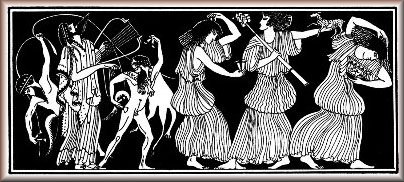
![]() The Nymphs' male equivalent are the
Satyrs,
who are deities of the woods and mountains. They are half human and half beast,
and they usually have a goat's tail, flanks and hooves.
While the upper part of the body is that of a human, they also have the horns of a
goat. They are the companions of Dionysus, the god of wine, and they spent their
time drinking, dancing, and chasing nymphs. The Italian version of the satyr is the
Faun.
The Nymphs' male equivalent are the
Satyrs,
who are deities of the woods and mountains. They are half human and half beast,
and they usually have a goat's tail, flanks and hooves.
While the upper part of the body is that of a human, they also have the horns of a
goat. They are the companions of Dionysus, the god of wine, and they spent their
time drinking, dancing, and chasing nymphs. The Italian version of the satyr is the
Faun.

© 2024 mythman.com
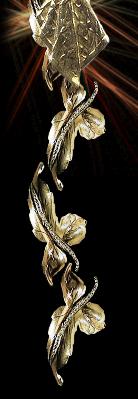
![]()
The Lotus flower was originally a
Nymph:
Lotis was a Nymph who was being pursued by the phallic deity Priapus, a
real brute of a man. Unwilling to give in to his amorous advances, Lotis instead
chose to transform into a lotus flower. That's how these beautiful flowers
came to be, according to the ancient Greeks.
![]()
Argyra was a Naiad who loved a
mortal
named Selemnus while he was still young and handsome; but later in time
as he grew old and she stayed young and beautiful, she would not visit him and
refused to see him when he called on her. Poor heart-broken Selemnus pined away
and died of love. The goddess of love Aphrodite took pity on him and he was turned
into the river Selemnus by her, who also made him forget Argyra.
![]()
Other stories of the Naiads were mythical
explanations of the origins of immortals and mortals. The sun god Helios mated with the Naiad Aegle (renowned as the most
beautiful of the Naiads) to produce the Charites (The Graces). Melite, a Naiad of the Aegaeus
River in Corcyra, had a liaison with Heracles and became the mother of Hyllus. Naiads were the lovers of
Endymion, Erichthonius,
Magnes, Lelex, Oebalus, Otrynteus, Icarius, and Thyestes and were therefore co-founders of important
families.
![]()
The
beautiful Nymph Oenone was the
daughter of the River God Cebren and an early love of the Trojan prince
Paris. Oenone had learned from Rhea, mother of Zeus, the art of prophecy, and
warned Paris not to sail to fetch Helen; as history tells us, Paris did not
heed his lover's advice, kidnapped Helen from Sparta, and ignited the Trojan
War.
![]()
Stories of the Naiads could take the form
of cautionary tales with unhappy endings. The Naiad, Nomia, fell in love with a handsome shepherd named Daphnis
and could not do enough for him. He repaid her love with unfaithfulness and in
turn she repaid his
betrayal by blinding him.
![]()
![]()



